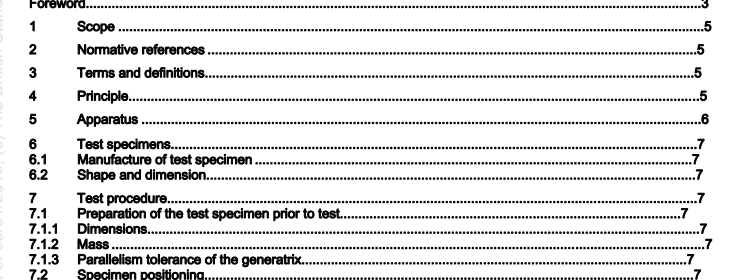BS EN 13286-42:2003 – Unbound and hydraulically bound mixtures — Part 42: Test method for the determination of the indirect tensile strength of hydraulically bound mixtures

1 Scope
This European Standard specifies a test method for the determination of the indirect tensile strength of cylindrical specimens of hydraulically bound mixtures. This European Standard applies to specimens manufactured in the laboratory or prepared from cores.
2 Normative references
This European Standard incorporates by dated or undated reference, provisions from other publications. These normative references are cited at the appropriate places in the text, and the publications are listed hereafter. For dated references, subsequent amendments to or revisions of any of these publications apply to this European Standard only when incorporated in it by amendment or revision. For undated references the latest edition of the publication referred to applies (including amendments).
prEN 13286-50, Unbound and hydraulically bound mixtures —Part 50: Method for the manufacture of test specimens of hydraulically bound mixtures using Proctor equipment or vibrating table compaction.
prEN 13286-51, Unbound and hydraulically bound mixtures —Part 51: Method for the manufacture of test specimens of hydraulically bound mixtures using vibrating hammer compaction.
prEN 13286-52, Unbound and hydraulically bound mixtures —Part 52: Method for the manufacture of test specimens of hydraulically bound mixtures using vibrocompression.
prEN 13286-53, Unbound and hydraulically bound mixtures —Part 53: Method for the manufacture of test specimens of hydraulically bound mixtures using axial compression.
3 Terms and definitions
For the purposes of this European Standard, the following terms and definitions apply.
3.1
hydraulically bound mixture
mixture that hardens by hydraulic and/or pozzolanic and/or sulphatic and/or carbonatic reaction, which usually has a workability to suit compaction by rolling and which is generally used in bases, sub-bases and capping layers
3.2
indirect tensile strength
stress at failure of a cylindrical specimen subjected to a compression force applied on two opposite generatrix
3.3
slenderness ratio
ratio of the length to the diameter of a cylindrical specimen
4 Principle
A cylindrical specimen of hydraulically bound mixtures is subjected to a compression force applied along the two opposite generatrix until failure (see Figure 1). The indirect tensile strength is calculated from the failure load.
5 Apparatus
5.1 Compression testing machine, capable of testing hydraulically bound mixtures cylindrical specimens, with the following requirements:
the precision of the machine and the load indication shall be such that the ultimate load, F , can be determined and measured to an accuracy of ± 1 %;
the loading platens shall be at least as large as, and preferably larger than the length of the specimen to which the load is applied. The surface flatness of the platens shall be less than 3 %;
provisions shall be made for alignment of specimens at the centre of the lower platens; visual alignment is not acceptable.
5.2 Packing or bearing strip, of plywood or hardboard, which shall be used only once. They shall have the following dimensions according to the dimension of the specimen:
length≥ H ;
width≥0,1 D ;
thickness (4±1) mm.
BS EN 13286-42:2003 – Unbound and hydraulically bound mixtures — Part 42: Test method for the determination of the indirect tensile strength of hydraulically bound mixtures